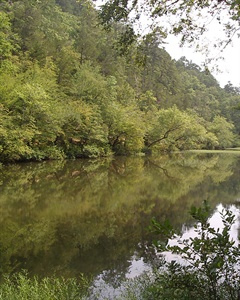The ANHC recently purchased a conservation easement on 232 acres in Saline County adjacent to over one mile of the Alum Fork of the Saline River, creating Alum Fork Natural Area (NA). Alum Fork NA is the 72nd natural area to be protected within the ANHC's statewide System of Natural Areas, which provides long-term protection to some of the state's most ecologically significant lands. The Nature Conservancy maintains fee title. The purchase of the easement was funded in part by Arkansas Natural and Cultural Resources Council (ANCRC) grant money.
The Alum, Middle, North, and South forks of the upper Saline River watershed support high biodiversity, but the Alum Fork is the most intact and of the highest quality. Alum Fork NA provides direct protection of the riparian and aquatic species, and natural communities, that occur within the Alum Fork of the Saline River, including habitat for at least four species of conservation concern.
Alum Fork NA contains habitat that supports the federally threatened Arkansas fatmucket (Lampsilis powellii), an endemic mussel found only in the Ouachita Mountains of Arkansas. Habitat is also supported for the Ouachita blazing-star (Liatris compacta), a plant species of conservation concern; Palmer's cornsalad (Valerianella palmeri), a plant species of conservation concern that is endemic to the Ouachita Mountains (not necessarily just in Arkansas); and three-way sedge (Dulichium arundinaceum var. arundinaceum), another plant species of conservation concern.
As well as protecting habitat within its boundaries, the natural area will indirectly protect species of concern downstream through reduced stream sedimentation and turbidity (cloudiness or haziness that affects the clarity of the water). Three other mussel species of conservation concern, the Ouachita kidneyshell (Ptychobranchus occidentalis), little spectaclecase (Villosa lienosa), and purple liliput (Toxolasma lividus); one fish species of concern, the Ouachita madtom (Noturus lachneri); and additional Arkansas fatmucket have been documented downstream. These species will also benefit from the natural area's protection.
Although the four forks of the Saline River are close to large population centers of Arkansas, currently there is limited public access. Alum Fork NA increases public access to the Alum Fork and its recreational opportunities, including kayaking, hunting, birding, and hiking.
